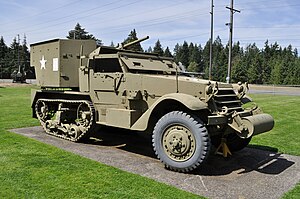| M15 Combination Gun Motor Carriage | |
|---|---|
 An M15A1 CGMC displayed at the Fort Lewis Military Museum | |
| Type | Self-propelled anti-aircraft gun |
| Place of origin | United States |
| Service history | |
| In service | 1943–53 |
| Used by | United States |
| Wars | World War II Korean War |
| Production history | |
| Designer | United States Army |
| Designed | 1940–42 |
| Manufacturer | Autocar Company |
| Produced | 1942–44 |
| No. built | 2,332 |
| Specifications | |
| Mass | 10 short tons (9.1 t) |
| Length | 20 ft 3 in (6.17 m) |
| Width | 7 ft 4 in (2.24 m) |
| Height | 7 ft 10 in (2.39 m) |
| Crew | 7 |
| Armor | 0–12 mm (0.00–0.47 in) |
Main armament | M1 37 mm (1.5 in) gun with 2 × .50 cal (12.7 mm (0.50 in)) M2 Browning machine guns |
| Engine | White 160AX, 386 in3 (6,330 cc) 6-cylinder, gasoline, compression ratio 6.3:1 128 hp (95 kW) |
| Power/weight | 15.8 hp/ton |
| Suspension | Half-track, vertical volute springs; front leaf spring |
| Fuel capacity | 60 US gal (230 L) |
Operational range | 150 mi (240 km) |
| Maximum speed | 41.9 mph (67.4 km/h) |
The M15 half-track, officially designated M15 Combination Gun Motor Carriage, was a self-propelled anti-aircraft gun on a half-track chassis used by the United States Army during World War II. It was equipped with one 37 millimeter (1.5 in) M1 autocannon and two water-cooled .50 caliber (12.7 mm) M2 Browning heavy machine guns.[1][2] Based on the M3 half-track chassis, it was produced by the Autocar Company between July 1942 and February 1944, and served alongside the M16 Multiple Gun Motor Carriage.[1]
The M15 evolved from the T28 project, an outgrowth of a 37 millimeter (1.5 in) gun mounted on an M2 half-track. Initially designated as the T28E1 Combination Gun Motor Carriage (CGMC), it was modified and accepted into service in 1943 as the M15.[1] While conceived as an anti-aircraft weapon, its 37 mm gun was often used as an infantry support weapon during the later stages of World War II. The M15A1 was an improved variant with air-cooled machine guns mounted below the 37 mm gun. The M15 "Special" was an M15 armed with a single Bofors 40 mm gun.
During World War II, the vehicle served the U.S. Army throughout the Mediterranean, European, and Pacific theaters of operations. In the Korean War, the M15 served alongside the M16 providing infantry support.
- ^ a b c Allen, Joshua (29 June 2024). "Combination Gun Motor Carriage M15 and M15A1". Tank Encyclopedia. Retrieved 29 June 2024.
- ^ Allen, Joshua (12 October 2024). "Motor, Carriage, Combination Gun T28E1". Tank Encyclopedia. Retrieved 12 October 2024.